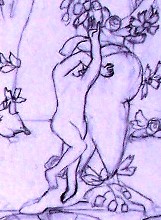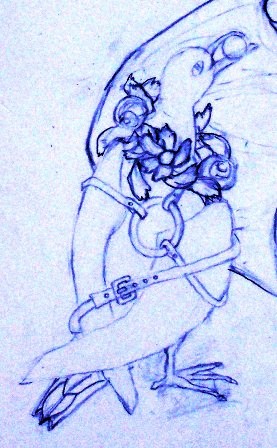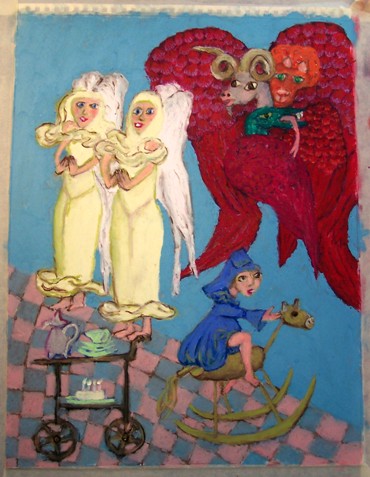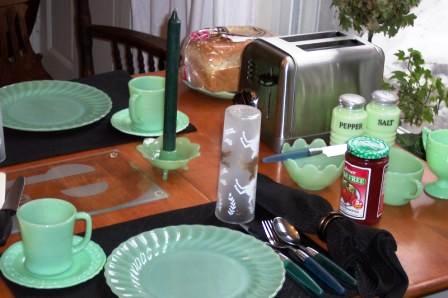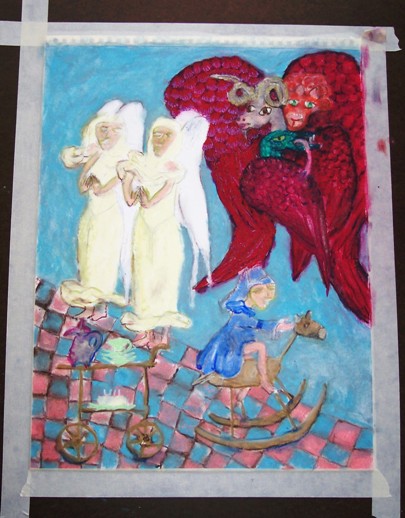Mood:
Topic: building business
I painted for three hours this morning. There was very little joy. It was simply the work that needed to be done, and I pushed myself. The underpainting is starting to look complex and lush. The multiple thin layers of transparent pigment has given all the objects a weighty, substantial look. Getting hungry with anticipation for the time to come when the underpainting is complete and I can start adding a top coat of color.
Mike said that my slow creative process is unusual. This whole process of preparation shows unusual creative restraint, and many amateur artists he has met don't have it. Creativity pushes some people with a rush of energy, and they move boldly froward with paint, canvass and brush. I tried that method once, and only once, and the canvass quickly was put out on the curb with the garbage.
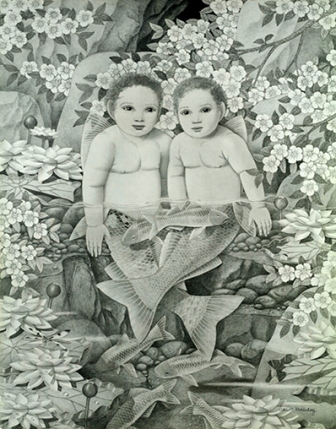 Yesterday I found an interview with Aaron Holliday, the schizophrenic painter I admire who painted "Baby Fish". I felt sad for Holliday because he took the same gamble that I am taking, trying to stand on his own two feet an make money as an artist. It backfired when he lost his social security income. Now he has no medical care for the schizophrenia and that is a very dangerous position to be in. The disease can be progressive, with psychosis worsening and brain damage resulting in an even lower level of artistic productivity. Un-medicated it is possible that he could lose that ability to make art for several years or even, forever. Somebody has to talk straight to Holliday about the severity of his illness and what he needs to do to defend his gift and his sanity. Somebody needs to say things that would break his heart, I bet that none of his caretakers has the guts to do it.
Yesterday I found an interview with Aaron Holliday, the schizophrenic painter I admire who painted "Baby Fish". I felt sad for Holliday because he took the same gamble that I am taking, trying to stand on his own two feet an make money as an artist. It backfired when he lost his social security income. Now he has no medical care for the schizophrenia and that is a very dangerous position to be in. The disease can be progressive, with psychosis worsening and brain damage resulting in an even lower level of artistic productivity. Un-medicated it is possible that he could lose that ability to make art for several years or even, forever. Somebody has to talk straight to Holliday about the severity of his illness and what he needs to do to defend his gift and his sanity. Somebody needs to say things that would break his heart, I bet that none of his caretakers has the guts to do it.Holliday's story illustrates what Mike and I call "The Myth of Recovery", where patients get subtle (and not so subtle) signals from society that full-time employment is possible, and levels of higher functioning can be attained through either education or willpower. In my recovery it is true that after many years (10 to 15) I can now write better and make more sophisticated art. But what has not changed is the hours during the day that I am sick. The proportion of low functioning hours of illness compared to high functioning hours of health has not changed.
It is my favorite daydream that I am magically granted the gift of eight working hours per day. I can paint non-stop for that amount of time, and oh, what wonders I would produce! My skill would leap forward as I learn from accident and experimentation. And at the end of a year I could stand in the middle of a room in a gallery and see my most recent work covering every wall.
In terms of recovery from schizophrenia it is true that over the years I have become more skilled. After the disastrous onset of the illness and global loss of cognitive ability, I am now more skilled at social interaction, at writing, at using art materials and at using a computer. But note what my education and advancement has cost me - I could not work any type of standard job while I was building up this narrow range of skill. There was a choice I had to make about 15 years, a fork in the road with two directions. First, I could work a part-time job, about 15 hours a week. The job would earn me extra money but I would have no energy left over for creative work. My friend Rocki went this route, first as a part-time student and then as a part-time worker in a library re-shelving books. She is a creative person who enjoys writing songs and short stories, and while she has talent, she had little time left after work in which to practice. Understand that since Rocki has a disease like my own, a lot of her time is spent, like me, simply being ill and withdrawn.
The alternative route was to discipline myself and write and make art as a self-taught, self-motivated agent. It was a terribly lonely route. There was no promise of either publication or if the artwork would sell. Very few people were interested in my progress. And while I was on disability it was in my best interest to work steadily in private and accrue skill, looking forward to the one day when I might, only might, burst forward upon the art world fully formed, like Athena from Zues's skull.
I wonder what Roger Ricco would say about my art?
And should I approach NARSAD with an artwork, and try to get some publicity through their agency? The only trouble is that NARSAD is political and they like really "upbeat" images to represent mentally ill persons, like pretty flowers and landscapes. Oh, and they don't like the work to look too childlike or primitive either. Better to show how "sophisticated" at using "artistic technique" the mentally ill person can be.
I went to the Ricco/Maresca gallery to grab a picture of Holliday's work. Well, the website was updated and Maresca no longer has Holliday listed as an artist client. The interview below took place three years ago. So I guess he didn't sell. There is just one schizophrenic client left, Ken Grimes. I was really happy to see new pictures of Grimes work. I don't know if my work is as strong as Grimes. Good, Better, Best. The world is judging you. You have the choice to listen or not.
Poor Aaron Holliday.
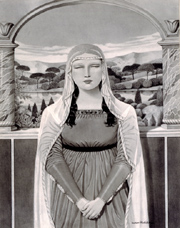 The Art of Aaron Holliday
The Art of Aaron HollidayThe artwork of Aaron Holliday can range from the surreal to the startlingly realistic. His pencil drawings are lush and intricately detailed; and his oil paintings employ the same attention to detail combined with a riot of color and depth.
By the time he was 13, Aaron Holliday had turned to drawing to alleviate his loneliness. Born in New York and raised in Los Angeles by his grandmother, he gradually withdrew from the world.
Eventually, he became so focused on drawing that he refused to go to school and had to be hospitalized. Mr. Holliday spent 3 years at Los Angeles County Hospital. Now 54, he currently resides in an assisted living facility.
Completely self-taught, Mr. Holliday works closely with the National Alliance for Research on Schizophrenia and Depression Artworks (NARSAD) to display and sell his artwork to the public.
The Ricco/Maresca Gallery in New York found out about Mr. Holliday through NARSAD and now has several of his pieces on display.
NARSAD Artworks showcases the talents of many gifted artists who happen to be mentally ill in an effort to help raise their self-esteem, as well as their income.
In addition to original artwork, pieces are available in the form of gift cards, calendars, lithographs, and postcards.
The group also raises money for projects that advocate on behalf of the mentally ill, and it promotes public education to destigmatize mental illness.
According to Roger Ricco of the Ricco/Maresca Gallery, Mr. Holliday's "work is extremely realistic, in contrast to primitive or brut art. He has this amazing skill to paint his ideas or draw his ideas. His paintings are surreal, but they also are very real in a way." "Birds on Scarf" has a translucence that helps give the painting a multidimensional feel.
Mr. Holliday's work brings together diverse sources and interests. "Ultimately, when [these interests] become a picture, they're almost perfectly real and at the same time; there's almost something wrong with it, in the sense of something is not normal, and I don't mean in a medical sense, but in terms of reality. What you end up with is a picture that looks like a room, and then you realize that everything about it is strange, but beautifully and wonderfully rendered," Mr. Ricco said.
"You might see a reflection in a mirror that you wouldn't expect to see, or the reflection goes back five times. From the art angle, his work stands on its own."
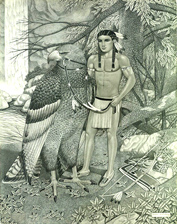 Many of Mr. Holliday's pencil drawings feature an eagle and a Native American character. In one, the eagle is soaring above mountains and a stream, with the full span of the bird's wing illustrated. In another, "Yellow Hawk", the bird is perched atop the outstretched arm of the Native American man with a forest backdrop The man is wearing long braids and a feather. Like all of Mr. Holliday's other works, these are finely detailed.
Many of Mr. Holliday's pencil drawings feature an eagle and a Native American character. In one, the eagle is soaring above mountains and a stream, with the full span of the bird's wing illustrated. In another, "Yellow Hawk", the bird is perched atop the outstretched arm of the Native American man with a forest backdrop The man is wearing long braids and a feather. Like all of Mr. Holliday's other works, these are finely detailed.In some of his more surreal works, a huge eagle stands on the ground next to the Native American man, and they are almost the same in height.
And in yet another, two chubby-cheek infants are framed against a backdrop of lush flowers. The work is titled "Babyfish" because instead of legs, the lower bodies of the infants are fish tails that appear to be submerged in clear water.
Mr. Rocco is particularly impressed with the quality of Mr. Holliday's paintings. "They are very elegant and probably historically accurate," he said.
Mr. Holliday's work can be viewed online at www.riccomaresca.com . He lives in Southern California.
The Artist's Reflections
There's no inspiration behind my work. A picture comes to mind, and there it is.
The length of time it takes to create depends on the piece. Each drawing takes about a month. A painting takes maybe a month and a half. It's really nothing shattering or scientific. It's just a thought I have in my mind.
Well, I'm not dead yet, but I want to say I've been painting all of my life. But I was drawing like this since I was a kid.
I've never been to a gallery. Ricco/Maresca Gallery is the first I've ever known. I've never even been there. It's the first gallery that's shown my work.
The drawings are simply pictures I put on canvas or on paper. It's a thought. I don't have a private collection of work. When I finish a piece, NARSAD takes it, and it goes into their traveling show.
I don't work every day at this. I may not work for months, and then I get the feeling to work. I'm working on a piece right now that I've had for a year. I hadn't worked on it for about 6 months, and I'm getting back at it. I get the feeling to work, and I do until I get tired of doing it. And then I don't want to do it for a while.
I've been diagnosed with schizophrenia, manic depression, I know it's called bipolar now, but this is years ago, back when I was in [Los Angeles] County Hospital when I was a child.
I'm not under a physician's care right now at all. I'm trying to get back on supplemental security income (SSI). I left SSI because I thought I could make a living on my art, but I cannot do it. I'm not doing anything for my medical care right now. I am diabetic and NARSAD helps me with my diabetes care, but as far as having a doctor, no.
My problem is schizophrenia. I hear voices and things like that. Sometimes good voices; sometimes very nice voices; sometimes very angry voices. But I'm not dangerous. I've never hurt anybody; never wished to hurt anybody. I hear the voices every day. Sometimes medication takes the voices away. But I don't want to be on medication.
When I have a clear mind, my work is beautiful, but when my mind is not clear, it's slightly schizophrenic. It's not terrible or ugly, but it's surrealism style.
"Babyfish" is slightly surreal. "Yellow Hawk" is not. The eagle on the Indian's arm, that's a normal position. If the eagle was carrying him, that would be surreal. Babyfish is slightly surreal 'cause babies don't have fish tales, but if you go to an aquarium and you see young fish, you think baby fish. And there are other pieces like that too, especially among my oil paintings. I have a piece called "Rhapsody." It's supposed to be music, and it's a big swirl.
I'm working on "Garden Path" now. It's of a woman in a garden, set in the 15th century, Dutch style. You know the saying "rose-colored glasses," and "going down the garden path," meaning you're not paying attention to your life and you're just about flowers and going down the garden path, and not doing anything with your life, well this was my thought behind the drawing. The woman is holding flowers, and she's in an old country garden. It's beautiful. It's coming in real good. It's a pencil drawing. I've been working on it for a year, more or less.
I really want to try to make a living from my art. I could not get a job doing anything. What kind of job could I have because of my illness?

 When they told me their plan I begged them for one more chance to make enough of a recovery that I be discharged to a half-way house. The hospital's criteria for wellness was that I cease being continuously suicidal and that I obtain and keep a part-time job outside of the Institute walls. Perhaps, then, an angel came to look over me for I was able to obtain a job at a prestigious world class museum in downtown Hartford, The Wadsworth Atheneum. At the interview for a position at the museum information desk, I was frank about my situation. I would walk from the Institute to the Wadsworth and then walk back home where I would be locked again on a psychiatric unit. The woman who would become my boss hired me. At first the job was volunteer, with the possibility of paid employment in the future.
When they told me their plan I begged them for one more chance to make enough of a recovery that I be discharged to a half-way house. The hospital's criteria for wellness was that I cease being continuously suicidal and that I obtain and keep a part-time job outside of the Institute walls. Perhaps, then, an angel came to look over me for I was able to obtain a job at a prestigious world class museum in downtown Hartford, The Wadsworth Atheneum. At the interview for a position at the museum information desk, I was frank about my situation. I would walk from the Institute to the Wadsworth and then walk back home where I would be locked again on a psychiatric unit. The woman who would become my boss hired me. At first the job was volunteer, with the possibility of paid employment in the future.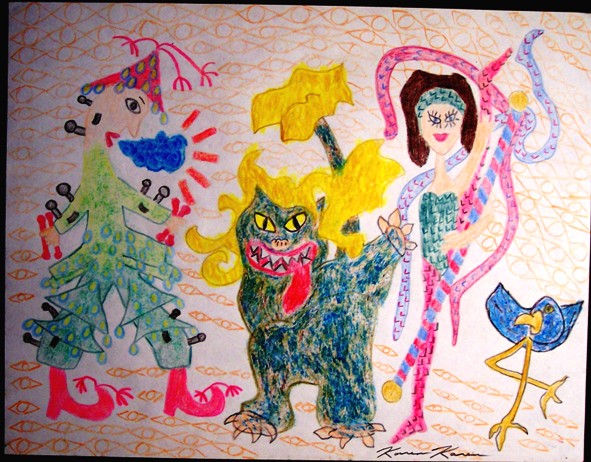 I also remember the art projects that I did on my own when I was in the hospital. Here is a drawing I made with colored pencils of three performers in a circus. You can get very board while you are locked up. I liked keeping busy. And look at the fun and curious world I got to escape to! I remember where the orange double triange and circle pattern came from. When I was first admitted because I felt suicidal my mind was so fragmented that all I could draw was the repetition of the triange and circle pattern. It made what looked like a row of eyes. I filled sheets of paper from top to bottom with the one pattern. I did this activity because there was no other activity my mind could do at that time.
I also remember the art projects that I did on my own when I was in the hospital. Here is a drawing I made with colored pencils of three performers in a circus. You can get very board while you are locked up. I liked keeping busy. And look at the fun and curious world I got to escape to! I remember where the orange double triange and circle pattern came from. When I was first admitted because I felt suicidal my mind was so fragmented that all I could draw was the repetition of the triange and circle pattern. It made what looked like a row of eyes. I filled sheets of paper from top to bottom with the one pattern. I did this activity because there was no other activity my mind could do at that time. 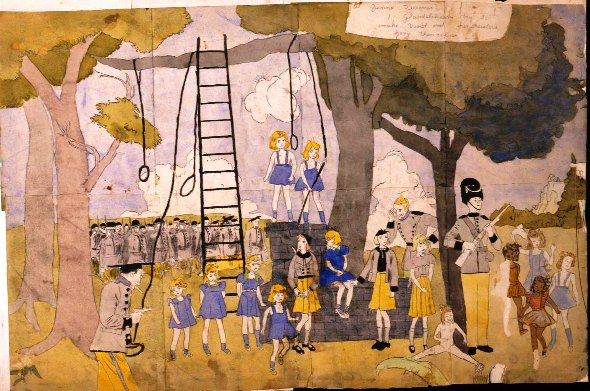
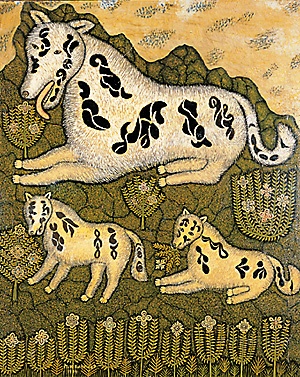 What are the artists you admire?
What are the artists you admire?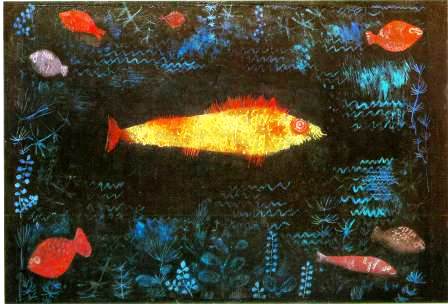
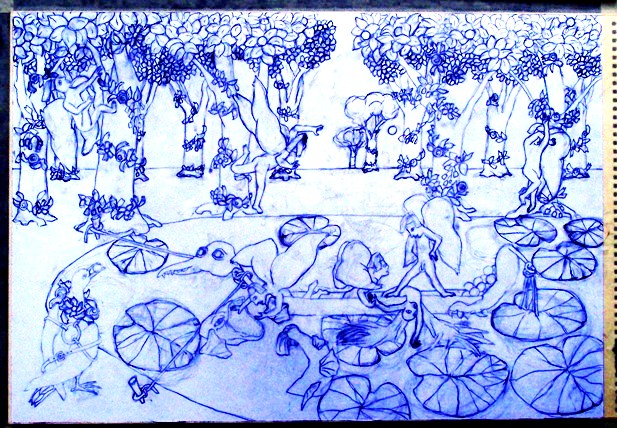
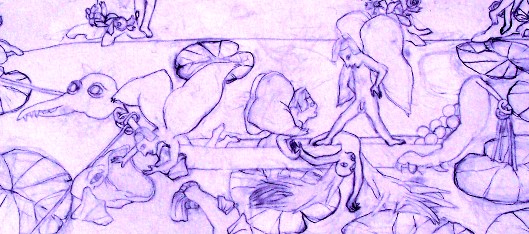
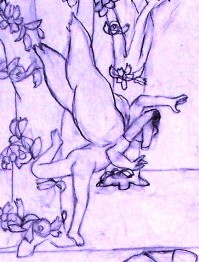 So when you see play in the drawing, is it mildly dark and violent?
So when you see play in the drawing, is it mildly dark and violent?